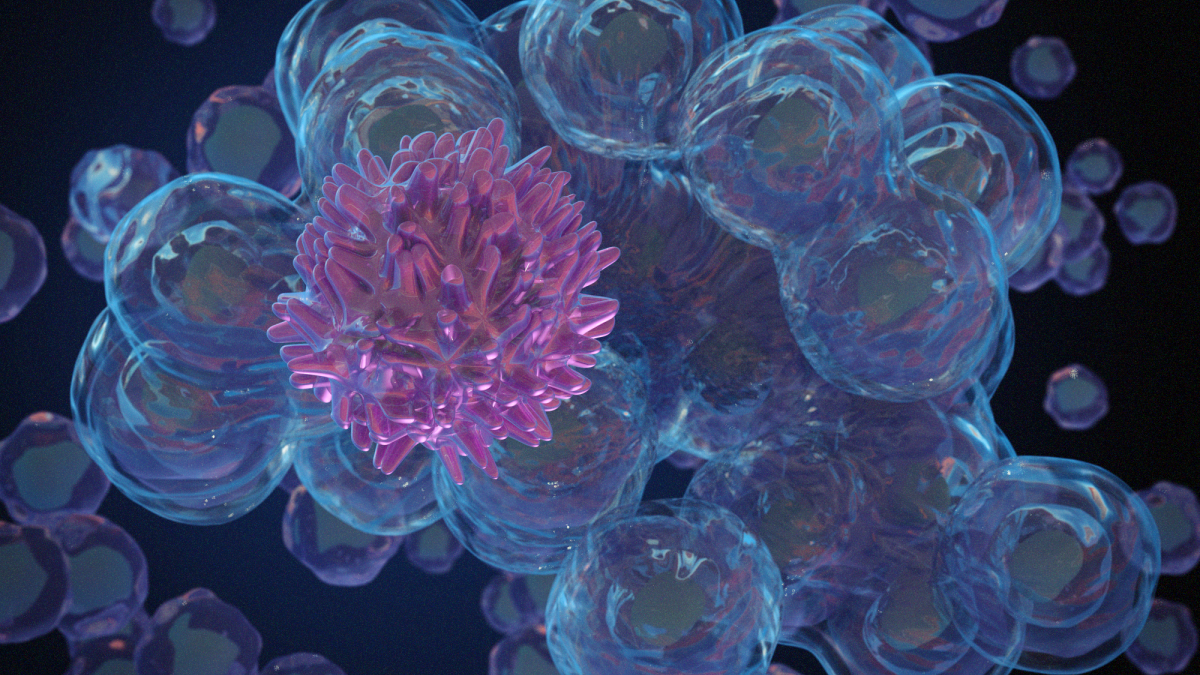Ancient stress response provides clues to cancer resistance

The new study examines the relative ages of human genes, including those implicated in cancer. The findings suggest that a propensity for rapid mutation — one of the hallmarks of cancer — may be ancient and deep-rooted. Graphic by Jason Drees for the Biodesign Institute
Cancer is often able to craftily outwit the best techniques modern medicine has developed to treat it. In an attempt to understand and combat cancer’s vaunted prowess, an unusual collaboration between physicists and a leading geneticist has cast new light on cancer as a biological phenomenon with very deep evolutionary roots.
ASU Regents’ Professor Paul Davies and a team of international researchers worked to trace the evolutionary history of cancer genes back to the dawn of multicellularity, over 1 billion years ago. Asking why these cancer genes evolved and what their functionality might be, the researchers hit on an astonishing link. Cancer cells deploy an ancient mechanism used by single-celled organisms to elevate their mutation rate in response to stress. This discovery explains one of the best-known hallmarks of cancer — its high mutation rate, which contributes to the rapid evolution of drug resistance.
The research involves looking anew at the genetic control switches that allow complex life to flourish. Should such regulation become corrupted, cells may lose their cooperative properties and regress to the single-celled behavior common to much more ancient organisms. Such reversion to ancestral evolutionary traits is known as atavism.
Davies, who is also director of the Beyond Center for Fundamental Concepts in Science, worked with physicist Charles Lineweaver, of the Australian National University, geneticist Kimberly Bussey and biophysicist Luis Cisneros, of NantOmics, LLC on the research.
“Lineweaver and I have long argued that cancer is a type of throwback to a more primitive ancestral form but we lacked the hard evidence," Davies said. "Now Kim Bussey and Luis Cisneros, with the help of students Adam Orr and Milica Miočević, have painstakingly analyzed the evolutionary origins of a large collection of cancer genes and confirmed that one of cancer’s most distinctive and troublesome hallmarks is indeed extremely ancient and deep-rooted. It has sweeping implications for therapy.”
The new study, which appears April 25 in the open-access journal PLOS ONE, finds that mutational bursts surrounding double-stranded breaks in DNA are commonly seen in cancer. Further, such bursts are similar to those seen in single-celled organisms engaged in stress-induced mutation. In the case of cancer, the mutations appear to be spread across the genome, including older genes that are evolutionarily conserved and normally off limits to mutational events. The effect is to allow somatic cells to search ancient genome space for solutions to the stress-induced pressures they are experiencing.
As corresponding author Kimberly J. Bussey, principal scientist with NantOmics and adjunct faculty in the Department of Biomedical Informatics at Arizona State University, explains, a stress response that evolved to protect single-celled organisms from extinction may prove hazardous to a multicellular creature, should some event suddenly resuscitate it.
“If you’re dealing with a unicellular organism and the population experiences some stress that it can’t deal with using the current toolbox of responses, for the population to survive — for the species to survive — it has to evolve. When a somatic cell in a multicellular organism evolves, cancer can occur.”
The results suggest that in cases of rapid resistance to therapy, the ability to generate regulated bursts of mutation may be at the core of this deadly disease.
“On the clinical side, I think this is really going to make us rethink what we mean by curing cancer. Maybe the goal isn’t curing but controlling,” Bussey said. “If this is a burst response, maybe there is a level of therapy with which we can impact the viability of the tumor cells but not actually induce the stress response.”
Such approaches have already made some inroads into clinical use. So-called metronomic therapy applies more frequent rounds of lower-dose treatment, while adaptive therapy seeks to pulse cancer treatments in order to stabilize rather than eradicate a tumor. These and other evolutionary approaches to treating cancer offer new hope in the war against a cunning and profoundly versatile foe.
More Science and technology

Compact X-ray laser lab aims to reveal deep secrets of life, matter and energy
X-rays allow us to view inside the human body to diagnose broken bones and other hidden problems. More recent X-ray advances are…

Apollo lunar samples enable ASU researcher to pinpoint moon’s crystallization timeline
A team of researchers, including Arizona State University geochemist Melanie Barboni, in collaboration with scientists from The…

NASA launches space telescope to chart the sky and millions of galaxies
California’s Vandenberg Space Force Base was the site for Tuesday’s 8:10 p.m. launch of the NASA SPHEREx mission aboard a SpaceX…

